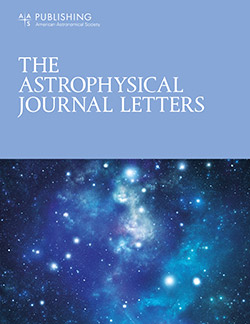FAST Discovery of a Fast Neutral Hydrogen Outflow
IF 8.8
1区 物理与天体物理
Q1 ASTRONOMY & ASTROPHYSICS
引用次数: 0
Abstract
Abstract In this letter, we report the discovery of a fast neutral hydrogen outflow in SDSS J145239.38+062738.0, a merging radio galaxy containing an optical type I active galactic nucleus (AGN). This discovery was made through observations conducted by the Five-hundred-meter Aperture Spherical radio Telescope (FAST) using redshifted 21 cm absorption. The outflow exhibits a blueshifted velocity likely up to ∼−1000 km s −1 with respect to the systemic velocity of the host galaxy with an absorption strength of ∼−0.6 mJy beam −1 corresponding to an optical depth of 0.002 at v = −500 km s −1 . The mass outflow rate ranges between 2.8 × 10 −2 and 3.6 M ⊙ yr −1 , implying an energy outflow rate ranging between 4.2 × 10 39 and 9.7 × 10 40 erg s −1 , assuming 100 K < T s < 1000 K. Plausible drivers of the outflow include the starbursts, AGN radiation, and radio jet, the last of which is considered the most likely culprit according to the kinematics. By analyzing the properties of the outflow, AGN, and jet, we find that if the H i outflow is driven by the AGN radiation, the AGN radiation does not seem powerful enough to provide negative feedback, whereas the radio jet shows the potential to provide negative feedback. Our observations contribute another example of a fast outflow detected in neutral hydrogen and demonstrate the capability of FAST in detecting such outflows.快速中性氢流出的发现
在这封信函中,我们报告了在SDSS J145239.38+062738.0中发现的快速中性氢流出,这是一个合并的射电星系,包含一个光学型I活动星系核(AGN)。这一发现是通过500米口径球面射电望远镜(FAST)使用红移21厘米吸收进行的观测得出的。相对于宿主星系的系统速度,流出物的蓝移速度可能高达~−1000 km s−1,吸收强度为~−0.6 mJy光束−1,对应于v =−500 km s−1时的光学深度为0.002。质量流出率在2.8 × 10−2和3.6 M⊙yr−1之间,这意味着假设100 K <,能量流出率在4.2 × 10 39和9.7 × 10 40 erg s−1之间;这是<1000 K。流出的可能驱动因素包括星暴、AGN辐射和射电喷流,根据运动学,最后一个被认为是最有可能的罪魁祸首。通过分析外流、AGN和喷流的特性,我们发现,如果H i外流是由AGN辐射驱动的,那么AGN辐射似乎不足以提供负反馈,而射电喷流则显示出提供负反馈的潜力。我们的观测提供了在中性氢中检测到快速流出的另一个例子,并证明了fast在检测这种流出方面的能力。
本文章由计算机程序翻译,如有差异,请以英文原文为准。
求助全文
约1分钟内获得全文
求助全文
来源期刊

Astrophysical Journal Letters
ASTRONOMY & ASTROPHYSICS-
CiteScore
14.10
自引率
6.30%
发文量
513
审稿时长
2-3 weeks
期刊介绍:
The Astrophysical Journal Letters (ApJL) is widely regarded as the foremost journal for swiftly disseminating groundbreaking astronomical research. It focuses on concise reports that highlight pivotal advancements in the field of astrophysics. By prioritizing timeliness and the generation of immediate interest among researchers, ApJL showcases articles featuring novel discoveries and critical findings that have a profound effect on the scientific community. Moreover, ApJL ensures that published articles are comprehensive in their scope, presenting context that can be readily comprehensible to scientists who may not possess expertise in the specific disciplines covered.
 求助内容:
求助内容: 应助结果提醒方式:
应助结果提醒方式:


